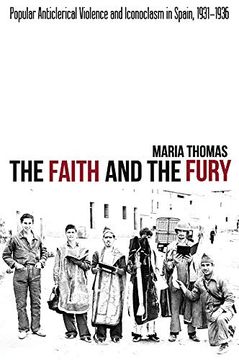Share
Faith and the Fury: Popular Anticlerical Violence & Iconoclasm in Spain, 1931-1936 (The Canada Blanch (in English)
Maria Thomas (Author)
·
Sussex Academic Press
· Paperback
Faith and the Fury: Popular Anticlerical Violence & Iconoclasm in Spain, 1931-1936 (The Canada Blanch (in English) - Maria Thomas
$ 51.37
$ 64.21
You save: $ 12.84
Choose the list to add your product or create one New List
✓ Product added successfully to the Wishlist.
Go to My WishlistsIt will be shipped from our warehouse between
Friday, June 21 and
Monday, June 24.
You will receive it anywhere in United States between 1 and 3 business days after shipment.
Synopsis "Faith and the Fury: Popular Anticlerical Violence & Iconoclasm in Spain, 1931-1936 (The Canada Blanch (in English)"
The five-year period following the proclamation of the Republic in April 1931 was marked by physical assaults upon the property and public ritual of the Spanish Catholic Church. These attacks were generally carried out by rural and urban anticlerical workers who were frustrated by the Republics practical inability to tackle the Churchs vast power. On 17-18 July 1936, a right-wing military rebellion divided Spain geographically, provoking the radical fragmentation of power in territory which remained under Republican authority. The coup marked the beginning of a conflict which developed into a full-scale civil war. Anticlerical protagonists, with the reconfigured structure of political opportunities working in their favour, participated in an unprecedented wave of iconoclasm and violence against the clergy. During the first six months of the conflict, innumerable religious buildings were destroyed and almost 7,000 religious personnel were killed. To date, scholarly interpretations of these violent acts were linked to irrationality, criminality and primitiveness. However, the reasons for these outbursts are more complex and deep-rooted: Spanish popular anticlericalism was undergoing a radical process of reconfiguration during the first three decades of the twentieth century. During a period of rapid social, cultural and political change, anticlerical acts took on new -- explicitly political -- meanings, becoming both a catalyst and a symptom of social change. After 17-18 July 1936, anticlerical violence became a constructive force for many of its protagonists: an instrument with which to build a new society. This book explores the motives, mentalities and collective identities of the groups involved in anticlericalism during the pre-war Spanish Second Republic and the Spanish Civil War, and is essential reading for all those interested in twentieth-century Spanish history. Published in association with the Canada Blanch Centre for Contemporary Spanish Studies.
- 0% (0)
- 0% (0)
- 0% (0)
- 0% (0)
- 0% (0)
All books in our catalog are Original.
The book is written in English.
The binding of this edition is Paperback.
✓ Producto agregado correctamente al carro, Ir a Pagar.

